Coronavirus (COVID-19): modelling the epidemic (issue no. 54)
Latest findings in modelling the COVID-19 epidemic in Scotland, both in terms of the spread of the disease through the population (epidemiological modelling) and of the demands it will place on the system, for example in terms of health care requirement.
This document is part of a collection
Coronavirus (COVID-19): modelling the epidemic in Scotland (Issue No. 54)
Background
This is a report on the Scottish Government modelling of the spread and level of Covid-19. This updates the previous publication on modelling of Covid-19 in Scotland published on 27 May 2021. The estimates in this document help the Scottish Government, the health service and the wider public sector plan and put into place what is needed to keep us safe and treat people who have the virus.
This edition of the research findings focuses on the epidemic as a whole, looking at estimates of R, growth rate and incidence as well as local measures of change in the epidemic.
In Scotland, the modelled estimate for R is between 1.1 and 1.3, with the growth rate increasing to between 2% and 5% and modelled estimates of infections now increasing over the next four weeks. There has been a rise in hospital beds in use by Covid-19 patients, which is projected to continue over the next four weeks. The increase in Covid-19 cases is also reflected in the wastewater data.
The measures modelled for this week, as described above, indicate that we are continuing to see a resurgence of the virus in Scotland, with considerable uncertainty as to what this means for future weeks.
Key Points
- The reproduction rate R in Scotland is currently estimated as being between 1.1 and 1.3. This is an increase in the bottom of the range since last week.
- The number of new daily infections for Scotland is estimated as being between 9 and 23, per 100,000 people. This has increased since last week.
- The growth rate for Scotland is currently estimated as being between 2% and 5%. This is an increase since last week.
- Average contacts have remained at a similar level in the last two weeks (comparing surveys pertaining to 6th – 12th May and 20th - 26th May) with a current level of 4.4 daily contacts.
- Contacts within the work and home setting have increased slightly, 6% and 7% respectively in comparison to two weeks prior and contacts within the school setting have increased by 31%. There has been a slight decrease in contacts within the other setting (contacts outside of those in the home, school and work), decreasing by 6%.
- Individuals aged under 49 increased their contacts whereas those aged over 49 reported a decrease in average daily contacts. The increases were largely driven by contacts within the work setting.
- The biggest increase in the proportion of participants visiting different locations is seen in those visiting a pub or restaurant increasing from 29% to 35% in the last two weeks, followed by visiting another home, increasing from 41% to 46%.
- Hospital bed and intensive care unit (ICU) occupancy are projected to plateau or rise over the next few weeks, as a result of relaxations of non-pharmaceutical interventions along with the likely impact of the Delta variant.
- Delta variant cases have slight demographic differences to Alpha variant cases (less deprived, slightly more in 25-34 age group) but a similar risk group and vaccination profile.
- Modelled rates of positive tests per 100K indicate that for the week commencing 13 June 2021, there are 14 local authorities with at least a 75% probability of exceeding 50 cases. Of those, 8 local authorities have at least a 75% probability of exceeding 100 cases. These are Edinburgh, Dundee, East Renfrewshire, Glasgow, Midlothian, North Lanarkshire, Renfrewshire and South Lanarkshire.
- The overall level of wastewater Covid-19 has risen substantially since last week, similar to levels seen in March 2021. In addition to continued high levels of wastewater Covid-19 near Glasgow, levels also rose near Edinburgh and Dundee.
Overview of Scottish Government Modelling
Epidemiology is the study of how diseases spread within populations. One way we do this is using our best understanding of the way the infection is passed on and how it affects people who catch it to create mathematical simulations. Because people who catch Covid-19 have a relatively long period in which they can pass it on to others before they begin to have symptoms, and the majority of people infected with the virus will experience mild symptoms, this "epidemiological modelling" provides insights into the epidemic that cannot easily be measured through testing e.g. of those with symptoms, as it estimates the total number of new daily infections and infectious people, including those who are asymptomatic or have mild symptoms.
Modelling also allows us to make short-term forecasts of what may happen with a degree of uncertainty. These can be used in health care and other planning. The modelling in this research findings is undertaken using different types of data which going forward aims to both model the progress of the epidemic in Scotland and provide early indications of where any changes are taking place.
Modelling outputs are provided here on the current epidemic in Scotland as a whole, based on a range of methods. Because it takes a little over three weeks on average for a person who catches Covid-19 to show symptoms, become sick, and either die or recover, there is a time lag in what our model can tell us about any re-emergence of the epidemic and where in Scotland this might occur. However modelling of Covid-19 deaths is an important measure of where Scotland lies in its epidemic as a whole. In addition, the modelling groups that feed into the SAGE consensus use a range of other data along with deaths in their estimates of R and the growth rate. These outputs are provided in this research findings. The type of data used in each model to estimate R is highlighted in Figure 1.
We use the Scottish Contact Survey (SCS) to inform a modelling technique based on the number of contacts between people. Over time, a greater proportion of the population will be vaccinated. This is likely to impact contact patterns and will become a greater part of the analysis going forwards.
The delivery of the vaccination programme will offer protection against severe disease and death. The modelling includes assumptions about compliance with restrictions and vaccine take-up. Work is still ongoing to understand how many vaccinated people might still spread the virus if infected. As Covid-19 is a new disease there remain uncertainties associated with vaccine effectiveness. Furthermore, there is a risk that new variants emerge for which immunisation is less effective.
The logistical model utilises results from the epidemiological modelling, principally the number of new infections. The results are split down by age group, and the model is used to give a projection of the number of people that will go to hospital, and potentially to ICU. This will continue to be based on both what we know about how different age groups are affected by the disease and the vaccination rate for those groups.
What the modelling tells us about the epidemic as a whole
The various groups which report to the Scientific Pandemic Influenza Group on Modelling (SPI-M) use different sources of data in their models (i.e. deaths, hospital admissions, cases) so their estimates of R are also based on these different methods. SAGE's consensus view across these methods, as of 2nd June, was that the value of R in Scotland was between 1.1 and 1.3 (see Figure 1). This has increased from the range of 1.0 to 1.3 last week[1].
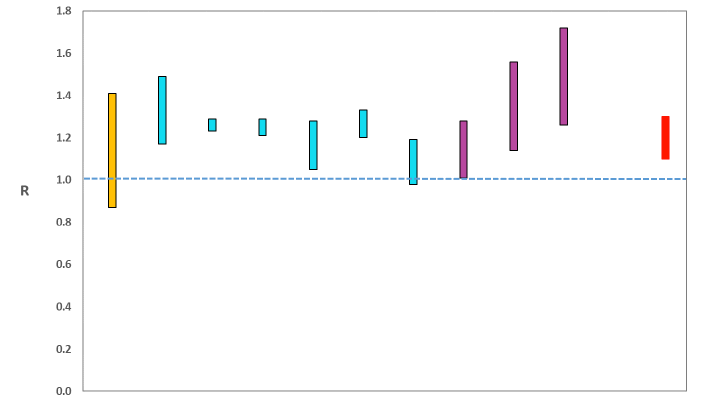
Source: Scientific Advisory Group for Emergencies (SAGE).
The various groups which report to the Scientific Pandemic Influenza Group on Modelling (SPI-M) use different sources of data in their models to produce estimates of incidence (Figure 2). SPI-M's consensus view across these methods, as of 2nd June, was that the incidence of new daily infections in Scotland was between 9 and 23 new infections per 100,000. This is an increase since last week. This equates to between 500 and 1,300 people becoming infected each day in Scotland.
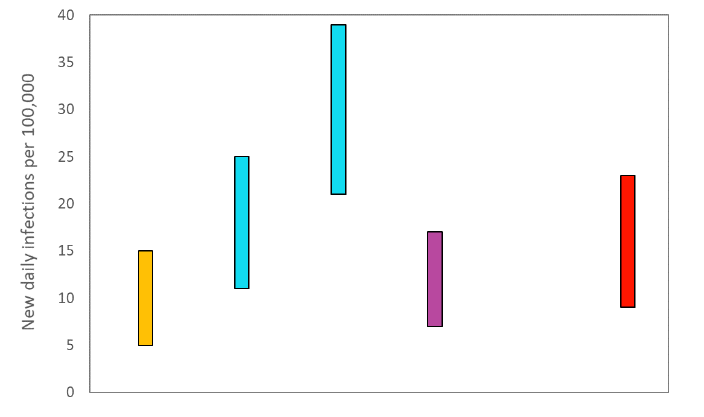
Source: Scientific Pandemic Influenza Group on Modelling (SPI-M).
The consensus from SAGE for this week is that the growth rate in Scotland is between 2% and 5% per day. This is an increase in the range from 26th May.
What we know about how people's contact patterns have changed
Average contacts have remained at a similar level in the last two weeks (comparing surveys pertaining to 6th – 12th May and 20th - 26th May) with a current level of 4.4 daily contacts as seen in Figure 3. Contacts within the work and home setting have increased slightly, 6% and 7% respectively in comparison to two weeks prior and contacts within the school setting have increased by 31%. There has been a slight decrease in contacts within the other setting (contacts outside of those in the home, school and work), decreasing by 6%.
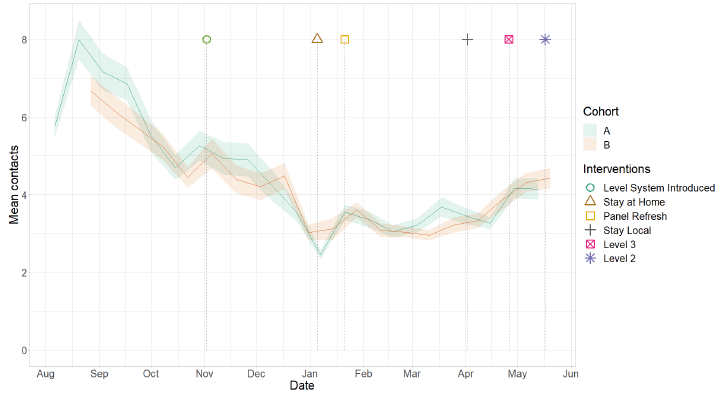
Figure 4 shows how contacts change across age group and setting. Individuals aged under 49 increased their contacts whereas those aged over 49 reported a decrease in average daily contacts. The increases were largely driven by contacts within the work setting. Those over 70 have shown a 22% increase in home contacts even though overall average daily contacts have decreased slightly.
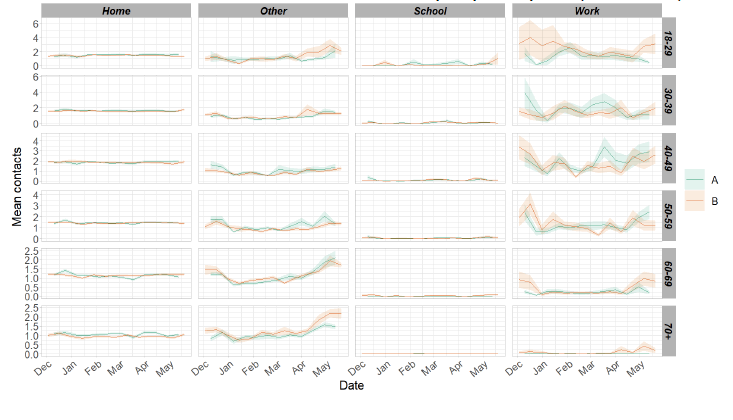
The heatmaps in Figure 5 show the mean overall contacts between age groups for the weeks relating to 29th April – 5th May and 13th - 19th May, and the difference between these periods. The biggest increase in interactions is seen between those under 18 with those aged between 18-49. Interactions between all remaining age groups continue to report interactions at similar levels two weeks prior, with the exception of those aged 18-29 who have reduced their contacts within their own age group.
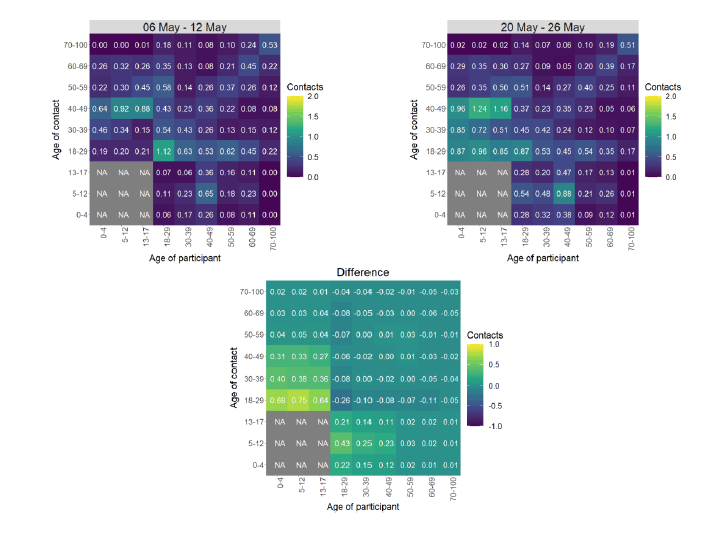
The biggest increase in the proportion of participants visiting different locations is seen in those visiting a pub or restaurant in Figure 6. This has increased from 29% to 35% in the last two weeks, followed by visiting another home, increasing from 41% to 46%.
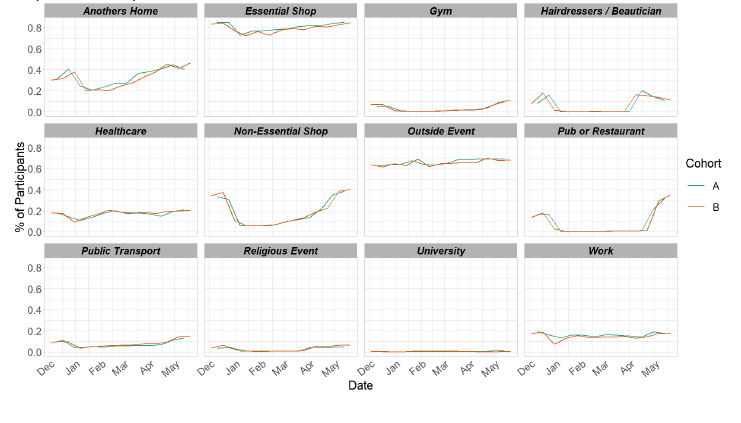
Vaccinations and contacts patterns
From Figure 7, it can be seen that where contacts have increased or remained level, hospitalisations have decreased across the majority of age groups, however, there has been a steady increase in cases for all age groups and a recent uptick in deaths in the oldest age groups.
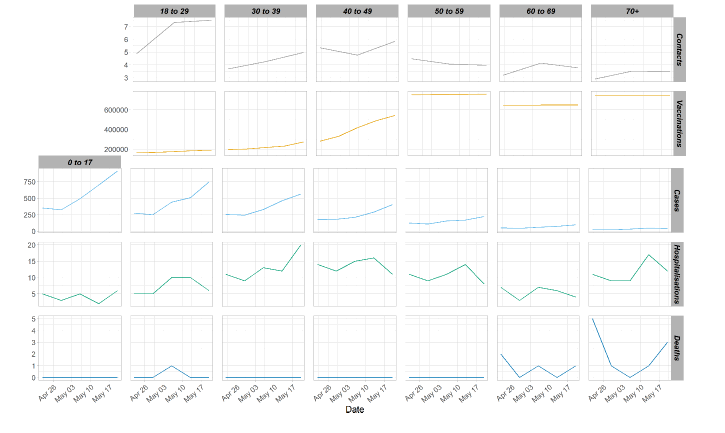
What the modelling tells us about estimated infections as well as Hospital and ICU bed demand
The Scottish Government assesses the impact of Covid-19 on the NHS in the next few weeks in terms of estimated number of infections. Figure 8 shows two projections[4], which take account of new variants (little impact for 'Better' and high impact for 'Worse')[5], as well as the recent increase in infections observed in the last two weeks.
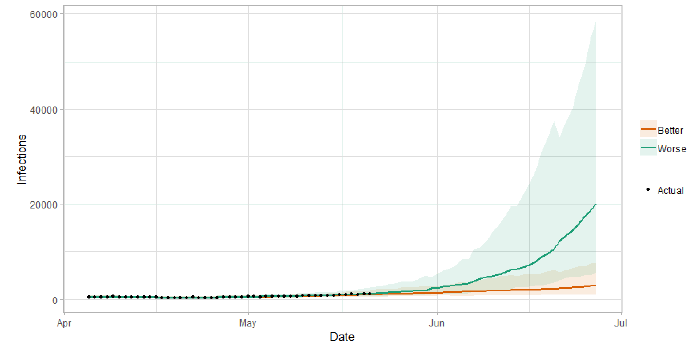
Figure 9 shows the impact of the projections on the number of people in hospital. The modelling includes all hospital stays, whereas the actuals only include stays up to 28 days duration that are linked to Covid-19. Work is ongoing to show the modelled occupancy for stays up to a 28 day limit.
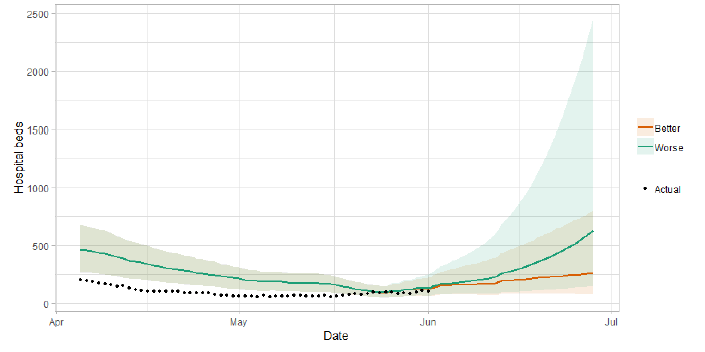
Figure 10 shows the impact of the projection on ICU bed demand.
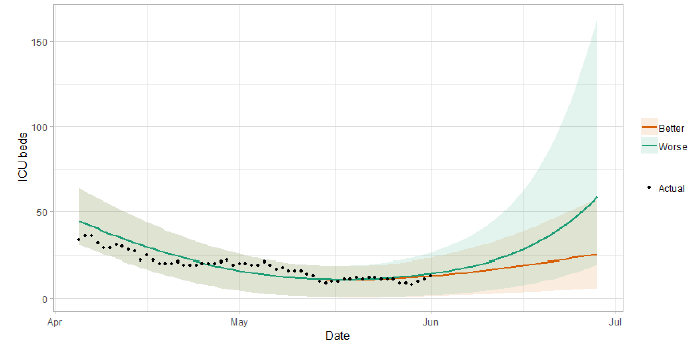
A comparison of the actual data against historical projections is included in the Technical Annex.
What the modelling tells us about projections of hospitalisations and deaths in the medium term
SAGE produces projections of the epidemic[8] (Figure 11), combining estimates from several independent models (including the Scottish Government's logistics modelling, as shown in Figures 8-10). These projections are not forecasts or predictions. They represent a scenario in which the trajectory of the epidemic continues to follow the trends that were seen in the data up to 31 May.
Modelling groups have used data from contact surveys, previous findings[9] and their own expert judgement and evidence from Public Health England, Scottish universities, Public Health Scotland and other published studies to incorporate recent relaxations on transmission and when making assumptions about vaccine effectiveness.
The projections do not include the effects of any other future policy or behavioural changes.
The delay between infection, developing symptoms, the need for hospital care, and death means they will not fully reflect the impact of behaviour changes in the two to three weeks prior to 31 May. Projecting forwards is difficult when the numbers of cases, admissions and deaths fall to very low levels, which can result in wider credible intervals reflecting greater uncertainty. The interquartile range can be used, with judgement, as the projection from which estimates may be derived for the next four weeks, albeit at lower confidence than the 90% credible interval.
These projections include the potential impact of vaccinations over the next four weeks.
Beyond two weeks, the projections become more uncertain with greater variability between individual models. This reflects the large differences that can result from fitting models to different data streams, and the influence of small deviations in estimated growth rates and current incidence.
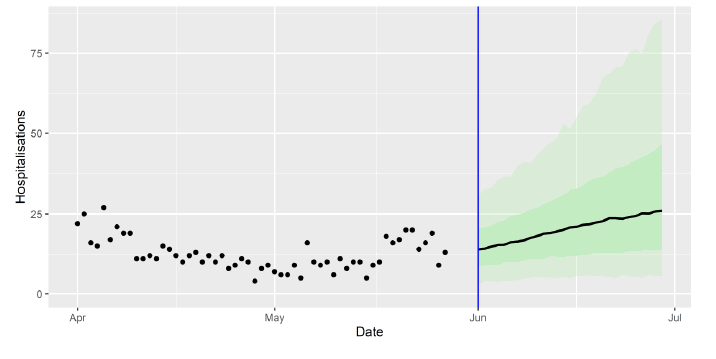
We are not projecting the numbers of people expected to die with Covid‑19 this week. The number of daily deaths has fallen to very low levels over recent weeks. Projecting forwards is difficult when numbers fall to very low levels, therefore SPI-M-O have decided to pause producing medium term projections for daily deaths in Scotland. SPI‑M‑O's consensus view is that the number of deaths will remain very low over the next four weeks.
What we know about who is testing positive with Covid
The Early Pandemic Evaluation and Enhanced Surveillance of Covid-19 (EAVE) 2 Study Group[10] has updated the pattern of demographics, clinical risk groups and vaccination status for those who tested positive in Scotland (see Technical Annex in issue 34 of the Research Findings). This data is based on the evidence presented to SPI-M on 26th May.
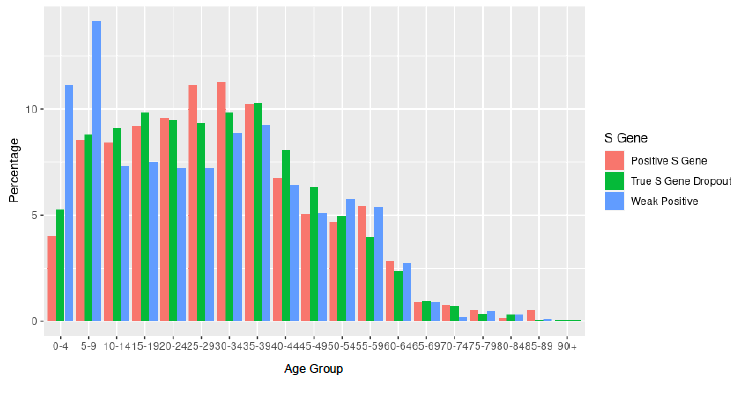
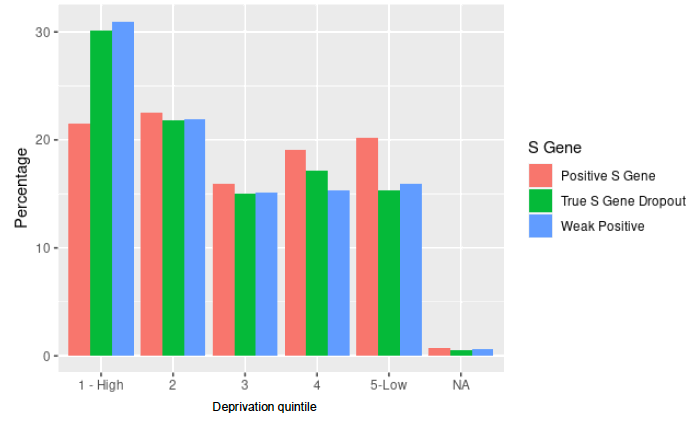
Delta variant cases[11] have slight demographic differences to Alpha[12] cases. As shown in Figure 12, there is a greater proportion with the Delta variant in the 25-34 age group. There are also indications that a greater proportion of Delta variant cases are from the least deprived group (see Figure 13). The risk group and vaccination profiles are similar.
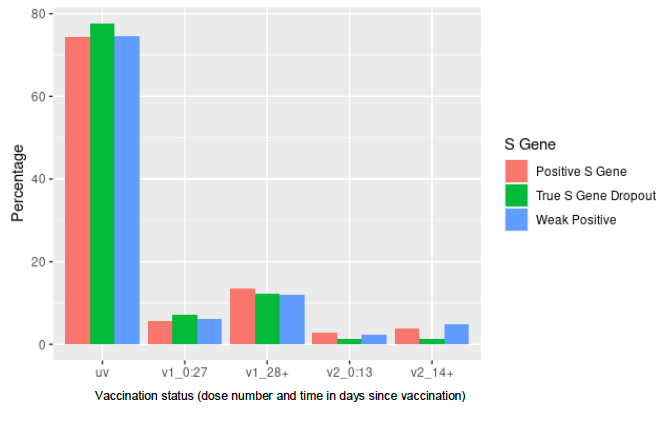
Figure 14 shows that 75% of cases are unvaccinated (uv). The pattern is similar for all S Gene groups.
What we know about which local authorities are likely to experience high levels of Covid-19 in two weeks' time
Exceedance is a tool which helps us to spot hotspots of Covid-19 where the number of new cases exceeds what was expected. As cases rise across the country, it becomes less informative as the background level of expected cases increases. As a result, this will not be reported this week.
We continue to use modelling based on Covid-19 cases and deaths from several academic groups to give us an indication of whether a local authority is likely to experience high levels of Covid-19 in the future. This has been compiled via SPI-M into a consensus. In this an area is defined as a hotspot if the two week prediction of cases (positive tests) per 100K population is predicted to exceed a threshold, e.g. 500 cases.
Modelled rates of positive tests per 100K (Figure 15) indicate that for the week commencing 13 June 2021, there are 14 local authorities with at least a 75% probability of exceeding 50 cases. These are Edinburgh, Dundee, East Ayrshire, East Dunbartonshire, East Renfrewshire, Fife, Glasgow, Midlothian, North Ayrshire, North Lanarkshire, Renfrewshire, South Ayrshire, South Lanarkshire and Stirling.
Of these, 8 local authorities have at least a 75% probability of exceeding 100 cases (Edinburgh, Dundee, East Renfrewshire, Glasgow, Midlothian, North Lanarkshire, Renfrewshire and South Lanarkshire).
There are no local authorities with at least a 75% probability of exceeding 300 cases.
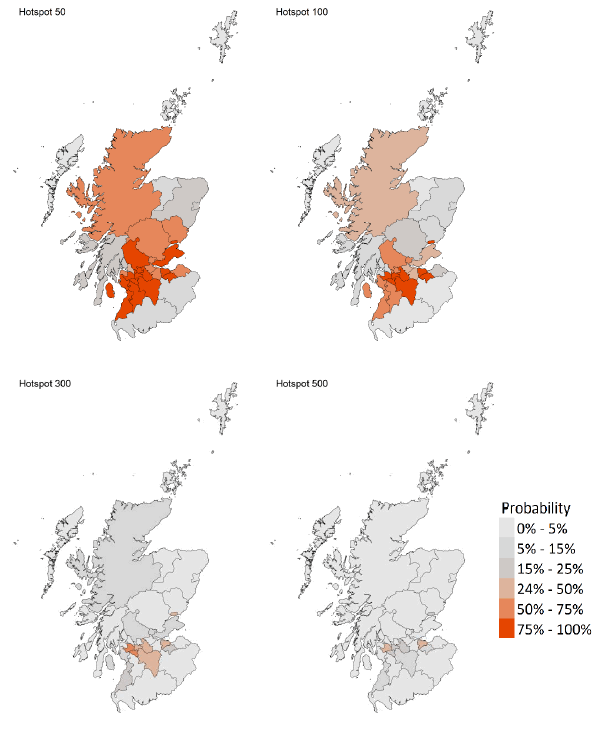
What can analysis of wastewater samples tell us about local outbreaks of Covid-19 infection?
Levels of COVID-19 RNA in wastewater collected at a number of sites around Scotland are adjusted for population and local changes in intake flow rate and compared to daily 7-day average positive case rates derived from Local Authority and Neighbourhood (Intermediate Zone) level aggregate data[13]. From this report onwards, an updated version of the flow normalisation procedure is employed whereby short-term trends at other sites are used to better predict flow when neither ammonia nor flow measurements are available for the sample at the time of reporting.
Nationwide, wastewater (WW) Covid-19 levels rose substantially, reaching levels similar to those seen in March. In addition to continued high levels near Glasgow, levels of WW Covid-19 and cases also rose near Edinburgh and Dundee.
Figure 16 shows the national aggregate for the original 28 sites with long‑term records (in blue) and, from January 2021, the aggregate for the full set of up to 107 currently sampled sites (in green)[14]. This aggregate shows a continued rise in WW Covid-19 to in excess of 10 million gene copies/person/day (Mgc/p/d), at least as fast as the also rising rate of new cases.
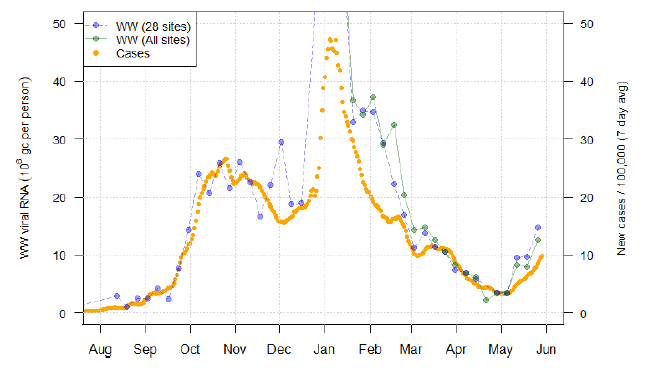
In the area around Glasgow, virus levels at sites like Shieldhall (Figure 17) and Dalmuir continue to be very high. While the most recent WW reading from Shieldhall does not show an increase in virus levels, this is insufficient to conclude at this stage that virus levels are stabilising. In addition, in sites outside of Glasgow such as Paisley (Figure 18), WW Covid-19 levels are rising in line with case rates.
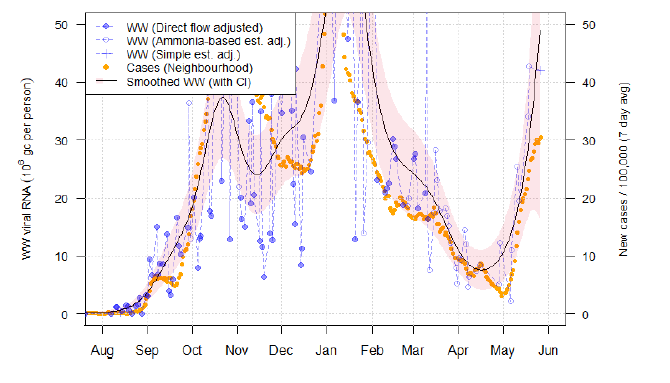
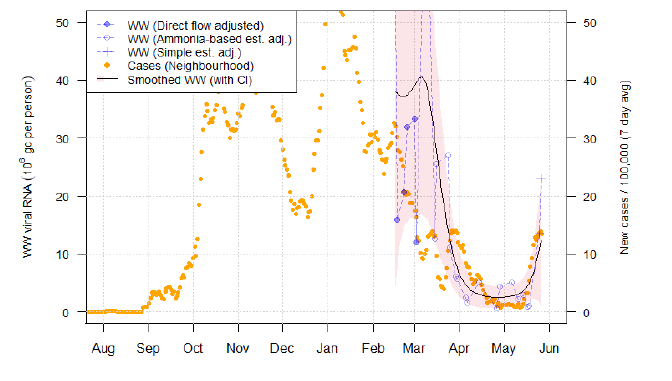
WW Covid-19 levels have also risen in Edinburgh, covered by the Seafield WW site (Figure 19). Whereas last week we saw rises in the adjacent Midlothian area, the rise seen at Seafield this week suggests increases over a larger area, matching the increase in cases in the area. A similar pattern in both cases and WW samples is seen in the Hatton site covering Dundee.
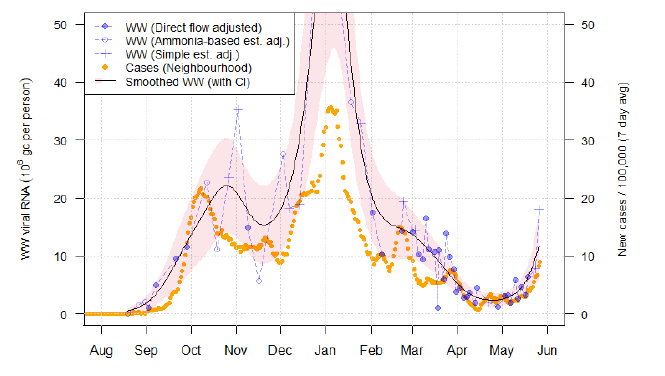
As the Shieldhall and Dalmuir sites serve several local authorities in and around Glasgow, it is difficult to localise the increase in WW Covid-19 observed to a specific area. However, South Lanarkshire and the local authorities in Ayrshire (Figure 20) also show increases in cases and WW Covid-19 levels despite little or no overlap with the Glasgow catchments. In the case of Ayrshire, we reported an increase in WW Covid-19 last week, pre-empting the rise in cases this week.
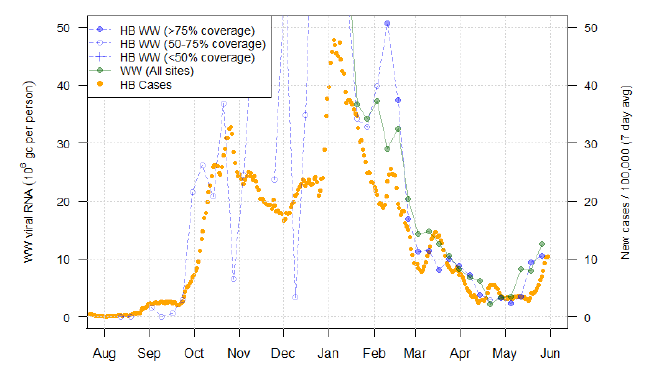
In Lerwick in the Shetlands, WW virus levels have remained at zero after a brief rise two weeks ago, and case rates have also fallen below the threshold of PHS censoring. In Alloa in Clackmannanshire, WW Covid‑19 levels fluctuate at levels somewhat lower than levels in the first half of May (at around 10 Mgc/p/d, compared to 20 Mgc/p/d earlier), similar to case rates which are down from last week though still relatively elevated (about 15 new cases/day/100k inhabitants).
Forres in Moray, and Dunblane near Stirling both showed a single, high WW Covid-19 measurement. Whilst the magnitude of these measurements (especially relative to much lower previous levels of WW RNA) may be anomalous, the simultaneous presence of a more modest rise in cases in both areas suggests possible outbreaks.
What next?
The Scottish Government continues to work with a number of academic modelling groups to develop other estimates of the epidemic in Scotland.
The modelled estimates of the numbers of new cases and infectious people will continue to be provided as measures of the epidemic as a whole, along with measures of the current point in the epidemic such as Rt and the growth rate. Further information can be found at https://www.gov.scot/coronavirus-covid-19.
We may report on exceedance in future weeks when the background levels of Covid-19 reduces so that it can be useful in identifying outbreaks.
Contact
There is a problem
Thanks for your feedback